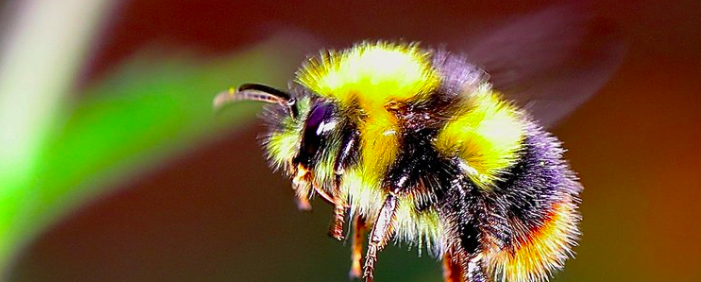
Bumblebees are large, sturdy insects with a body covered with hair. They are usually between 6 and 25mm long. Their bodies are often colored black and yellow, sometimes with orange, red or white patterns.
In females, the hind legs are modified to facilitate the collection and transport of pollen. Their abdomen ends in a sting.
These insects form organized societies whose individuals are divided into three castes. The queen is the largest insect in the colony and measures between 13 and 32 mm in length. The workers have a size varying between 7 and 18 mm. Male bumblebees are between 10 and 17mm long.
Life cycle
Bumblebees form new colonies every year. Only the young, fertilized queens spend the winter. They come out early in the spring and look for a place to make their nests. This is usually underground, in an already existing cavity.
In the nest, the queen builds two wax cells the size of a thimble. One of them will host the first eggs. The queen fills the other with nectar and uses it as a pantry while she tends to her eggs.
The eggs, five to 20 in number, are deposited in the egg-laying cell on a reserve of pollen and nectar. The queen covers everything with wax and settles on the cell to brood. Hatching takes place three to five days later. The young larvae feed in the cell. After seven or eight days, each larva makes a cocoon in which it turns into a nymph. Adult workers emerge after 12 to 14 days. These sterile females will take care of the next generation produced by the queen.
This continues to lay eggs and build cells for the brood. She lays three or four eggs per cell, which will also give birth to workers.
Towards the end of summer, the queen lays unfertilized eggs which give birth to fertile males and females. Once adults, these insects leave the nest and mate. The future fertilized queens then take shelter to spend the winter. The rest of the colony died with the onset of the cold.
Habitat
Bumblebees frequent forests, mountainous regions, bogs, fields and other places where nectar-bearing plants flourish.
What you need to know
These insects produce honey, but much less than honey bees , which must accumulate provisions to survive the winter. Bumblebees store honey only to meet the short-term needs of the colony.
Female bumblebees (queen and worker) can inflict a painful sting when provoked. Bumblebees do not die after biting. They can dart their smooth sting at the same victim several times.
Ecological roles
Bumblebees are important pollinating insects and thus help maintain plant diversity.